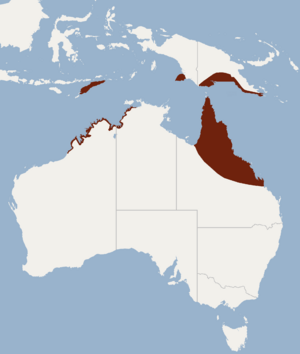Northern broad-nosed bat facts for kids
Quick facts for kids Northern broad-nosed bat |
|
|---|---|
| Conservation status | |
| Scientific classification | |
| Genus: |
Scotorepens
|
| Species: |
sanborni
|
 |
|
The northern broad-nosed bat (Scotorepens sanborni) is a small bat from the vespertilionid family. These bats are also called microbats. You can find them in northern Australia, Timor-Leste, and Papua New Guinea.
Contents
Discovering the Northern Broad-Nosed Bat
A scientist named Ellis Le Geyt Troughton first described this bat in 1937. He first thought it belonged to a different group of bats. Later, another scientist, Darrell Kitchener, studied the bat again. He decided it was its own unique species, not just a subspecies. Troughton named the bat sanborni to honor Colin C. Sanborn. Sanborn was a curator at the Field Museum of Natural History. Troughton was thankful for Sanborn's help while he was studying mammals in Chicago. Scientists have found that the two groups of these bats in Australia are genetically different.
What the Northern Broad-Nosed Bat Looks Like
This bat is a type of Scotorepens bat. It looks a lot like the widespread S. balstoni bat. However, the northern broad-nosed bat is slightly larger. Its snout, or nose area, has no hair. It also has special glands that are common in this type of bat. The fur color can be different for each bat. The fur on its back is a sandy or olive-brown color. The fur on its belly is lighter, a pale grayish-brown with whitish tips.
Size and Weight of These Bats
The size of these bats changes depending on where they live in Australia. Bats in the east and north tend to be larger. For bats in the northwest (Kimberley and Top End areas):
- Their forearm length is about 28 to 34 millimeters (average 31 mm).
- Their head and body together are 37 to 48 mm long.
- Their tail is 27 to 36 mm long.
- Their ears are about 9 to 12 mm long (average 10 mm).
- They weigh about 5.7 to 7.3 grams (average 6.5 g).
For bats in Queensland, they are a bit bigger:
- Their forearm length is about 31 to 36 mm (average 33 mm).
- Their head and body together are 40 to 52 mm long.
- Their tail is 29 to 39 mm long.
- Their ears are 10 to 13 mm long.
- They weigh about 5.7 to 9.1 grams (average 7.3 g).
Where Northern Broad-Nosed Bats Live
These bats live in many places. Their home range includes Timor-Leste, Papua New Guinea, and the northern coast of Australia.
Australian Habitats
In northern Australia, there are two main groups of these bats. They live in different areas. One group lives from the western Top End to the Kimberley region. These bats prefer coastal and near-coastal wooded areas. They also like mangrove forests and places near water. Another group lives north of Rockhampton in Queensland. They are found inland from the coast, up to the Cape York peninsula. These bats live in heathlands, open woodlands, and monsoon forests.
Behaviour and Reproduction
During the day, these bats usually sleep in tree hollows. Sometimes, they also use buildings as roosts. They are often seen hunting for small flying insects. They especially like to eat midges and mosquitoes. They hunt for these insects over open water. Northern broad-nosed bats have their babies between September and November.
See also
 In Spanish: Scotorepens sanborni para niños
In Spanish: Scotorepens sanborni para niños


